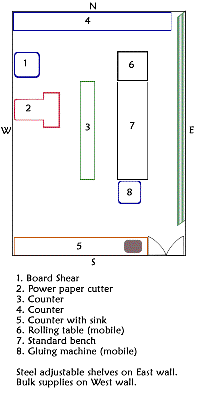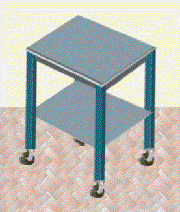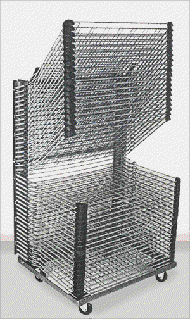Layout
** **Although the layout of a conservation operation depends on the amount and type of space available, there are some basic requirements to consider. It is useful to draw up a floor plan on graph paper and experiment with different layouts. This will ensure that adequate space is assigned for furniture, machines, services, and utilities, and that the best possible use is made of that space.
**Although the layout of a conservation operation depends on the amount and type of space available, there are some basic requirements to consider. It is useful to draw up a floor plan on graph paper and experiment with different layouts. This will ensure that adequate space is assigned for furniture, machines, services, and utilities, and that the best possible use is made of that space.
All benches and work surfaces should be a standard 96 centimeters high. This height has been found to work well with staff of various sizes and is designed to allow staff to work standing or sitting on adjustable stools or chairs. For most conservation functions, it is best that staff stand and move to fully utilize all the work surface. For this reason, the work surface should be large (suggested standard bench is 2.44 meters x 1.24 meters), with materials spread along its surface to encourage staff to work on groups of materials. For paper conservators, it is useful to have collapsible tables with a lower height of 77 centimeters for working on oversize materials such as maps. The lower height allows the staff to reach the center of a large piece.
Space between benches and other work surfaces should be a minimum of 1 meter. This allows staff to move about freely and book trucks to navigate through. Benches should not be placed against a wall; there should be enough space to allow a number of staff to work on group projects at the same bench.
Machines should generally be grouped along a wall, their placement determined by their use. For example, leaf casters, which require water, need to be close to a sink, and the suction table should be within easy reach of the fume hood/cupboard so that solvents can be vented. In a stiffeningoperation, the power paper cutter should always be sited against a wall and the machine gluing function should be performed close to a sink.
** **The rolling table is the same height and width as the standard bench but half the length, with a work surface area of 1.24 meters x 1.24 meters. Lockable wheels allow the table to be set against a standard bench, and it can be lengthened if needed. Drying racks, used for both book and paper conservation, should be mobile and moved against the wall when not needed.
**The rolling table is the same height and width as the standard bench but half the length, with a work surface area of 1.24 meters x 1.24 meters. Lockable wheels allow the table to be set against a standard bench, and it can be lengthened if needed. Drying racks, used for both book and paper conservation, should be mobile and moved against the wall when not needed.
